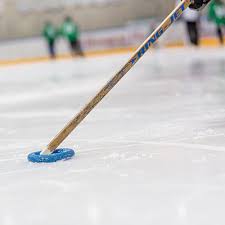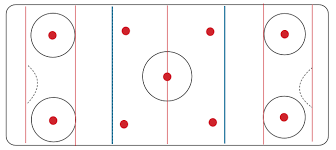What is Ringette?
Similar to hockey, Ringette is played on the ice with skates. Two teams are competing against each other. Usually, there are 11 to 17 playears on one team. There are six players (two defenders, one center, two forwards, and one goalie) on each team which is 12 players in total on the ice at the same time. The objective is the score as many goals as possible by putting the ring into the net of the opposing team (What is ringette? ).
Each player has a straight stick to pass, shoot, and control the ring and it is played with one 8-inch ring which is blue, hollow and made of rubber (Ringette rules).

The entire equipement is made up of:
- Helmet
- Neck Guard
- Elbow pads
- Jersey
- Gloves
- Girlde/pelvic protection
- Ringette pants
- Shin pads
- Skates
- Ringette Stick
Rink

The Rules
- - Blue line
- A player cannot carry the ring over any of the two blue lines. She must pass the ring over the line to her teammate who is allowed to skate ahead the ring carrier. If the ring crossed the two line at the same time, her teammates are not allowed to touch the ring until the other team touvhes it frist.
- - Goalkeeper’s crease
- No players are allowed to enter the crease of the goaler. If the ring goes into the crease, only the goaler can throw it to her teamates which she has 5 seconds to do.
- - Shot Lock
- Each team has 30 seconds to take a shot at the goaler after the possession of the ring. If the team fails to do so, the timer buzzes and th ring goes to the other team. If the opposing team takes the ring away, the buzzer re-starts.
- - Offensive zones
- The zones are limited by the small red lines at the top of the circles on top of each net. In these zones, there are three players of each teams who are allowed (excluding the goaler).
- - Contact
- No body contact is allowed in ringette. If contact does occur, penalties are given to the players who committed the contact.
- - Penalties
- Penalties are usually two minutes (minor) but can be four minutes (major). They are given out by one of the two referees. The most common ones are: slashing, tripping, obstruction and high-stick. A player can get up to 10 minutes of penalty before getting sent off.